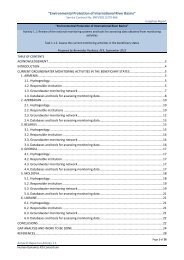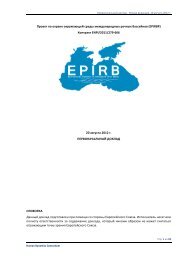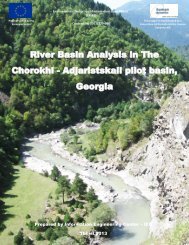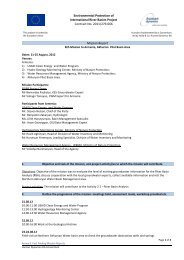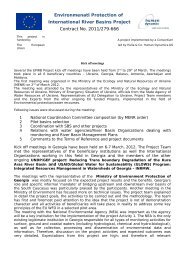Nokia Standard Document Template - Environmental Protection of ...
Nokia Standard Document Template - Environmental Protection of ...
Nokia Standard Document Template - Environmental Protection of ...
- No tags were found...
Create successful ePaper yourself
Turn your PDF publications into a flip-book with our unique Google optimized e-Paper software.
4th Mission Report _KE3_Jan –Feb 2013The KE3 reviewed the latest developments regarding the BMI analysis with Ms Vafa Nasibova, Head <strong>of</strong>Biomonitoring.The staff had previously been trained by other projects on the sampling <strong>of</strong> Benthic Macro-invertebrates(BMI). They have previously taken hydrobiological samples and analysed the BMIs. They still require moretraining on the identification <strong>of</strong> the species, the calculation <strong>of</strong> biotic indices and EQRs.Training CoursesAs the Department already does analyse quality controls, it requires only a few extra simple steps toconstruct the Shewhart chart and calculate the acceptable precision. With this in mind, the KE3 submitteda local AQC workshop training on the theoretical principles <strong>of</strong> internal quality controls, and was followedup by undertaking an exercise with the analysts using their own previous data to calculate the charts andprecision statistics.The local training workshop was presented on 20th February, to 22 trainees (Appendix 7) and covered thefollowing topics:i. Production <strong>of</strong> <strong>Standard</strong> Operating Procedures (SOPs)ii. Laboratory Information Management Systems (LIMS)iii. Introduction to Analytical Quality Control, Precision and Accuracyiv. The application <strong>of</strong> Excel Spreadsheets to calculate the AQC parameters.On 21st February the KE3 submitted further training, working with 7 analysts (Appendix 7) to apply simpleExcel Spreadsheets to calculate the statistical parameters using their own results for Ammonia tocalculate the precision <strong>of</strong> their method and to construct the Shewhart Chart. Following this hands onapproach, all the delegates were confident in undertaking these calculations on their own. The electroniccopy <strong>of</strong> the calculation was submitted to them as a reference example. Therefore there should be noproblem for the Department to produce their own correct internal quality controls for most <strong>of</strong> theirparameters in time for the JFS. Furthermore, the KE3 would be available to provide any further support t<strong>of</strong>acilitate this by distance training.On 21st February the KE3 also submitted further local training course on the GLC techniques used foranalysing OCP to 6 trainees (Appendix 7).Water Body Delineation 22nd – 23rd FebruaryAn initial meeting was held between KE3 and KE2, KE4, KE5, GIS Expert , Rafig Verdiyev CWM, FaridGarayev Translator.It was decided that to progress the delineation <strong>of</strong> the water bodies at risk Chapter 3 <strong>of</strong> the RBA wasrequired, which focuses on Pressures and Impacts but this had still to be produced. Therefore the KE3arranged a meeting with the author, Pr<strong>of</strong>essor Fada Imarov, at Baku State University on 22nd February.Pr<strong>of</strong>. Fada stated that the main pressures on the Project pilot rivers were:i. Manmade reservoirs on 3 <strong>of</strong> the 4 rivers which impacting on the normal flows <strong>of</strong> the rivers andcause dried rivers during the summer time. Uncontrolled water abstraction for irrigation.ii. Uncontrolled water abstraction for irrigation.iii. Illegal logging for fuel, causing deforestation, - this has diminished recently owing to gas beingsupplied to more communities.Page 9 <strong>of</strong> 36




